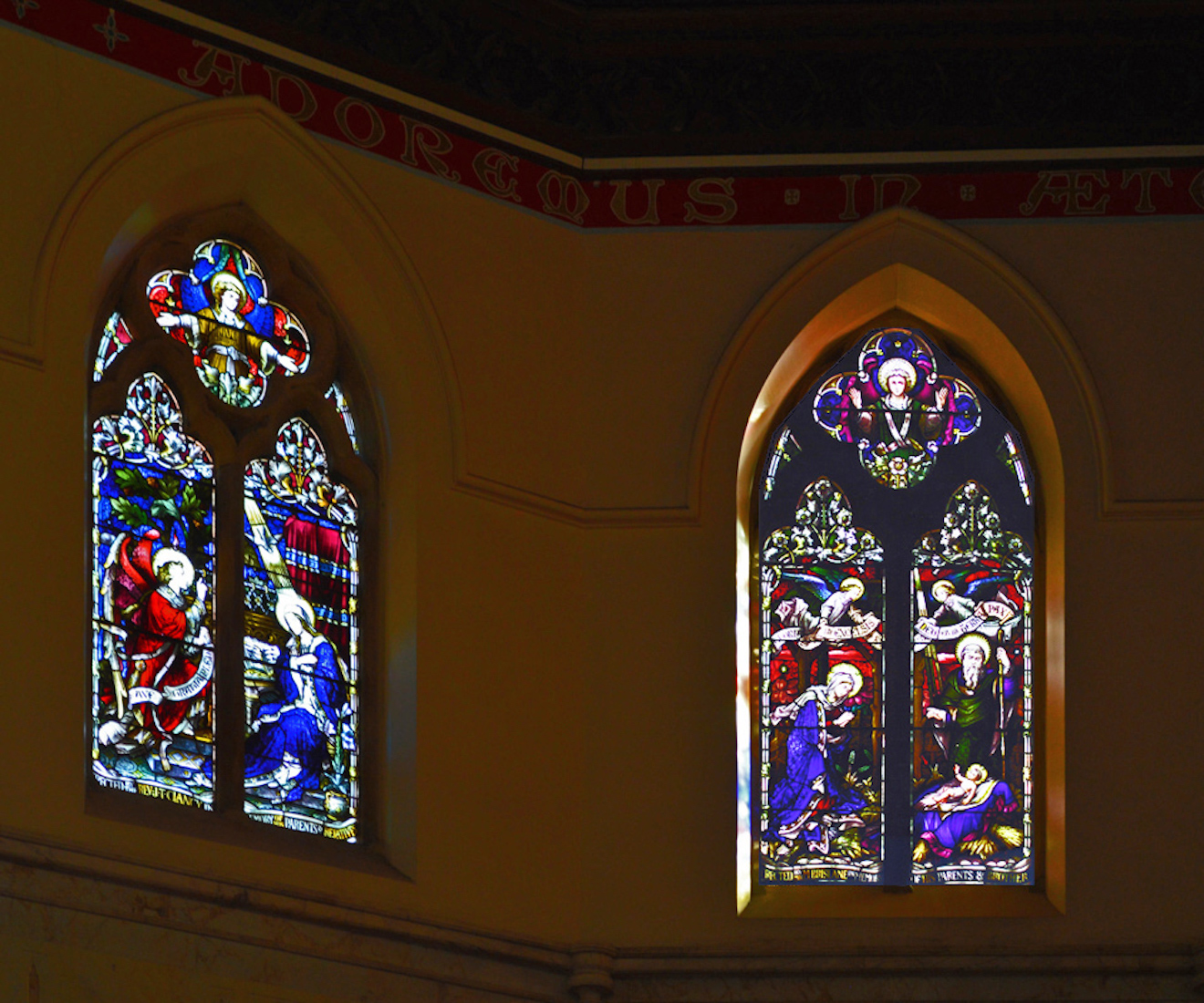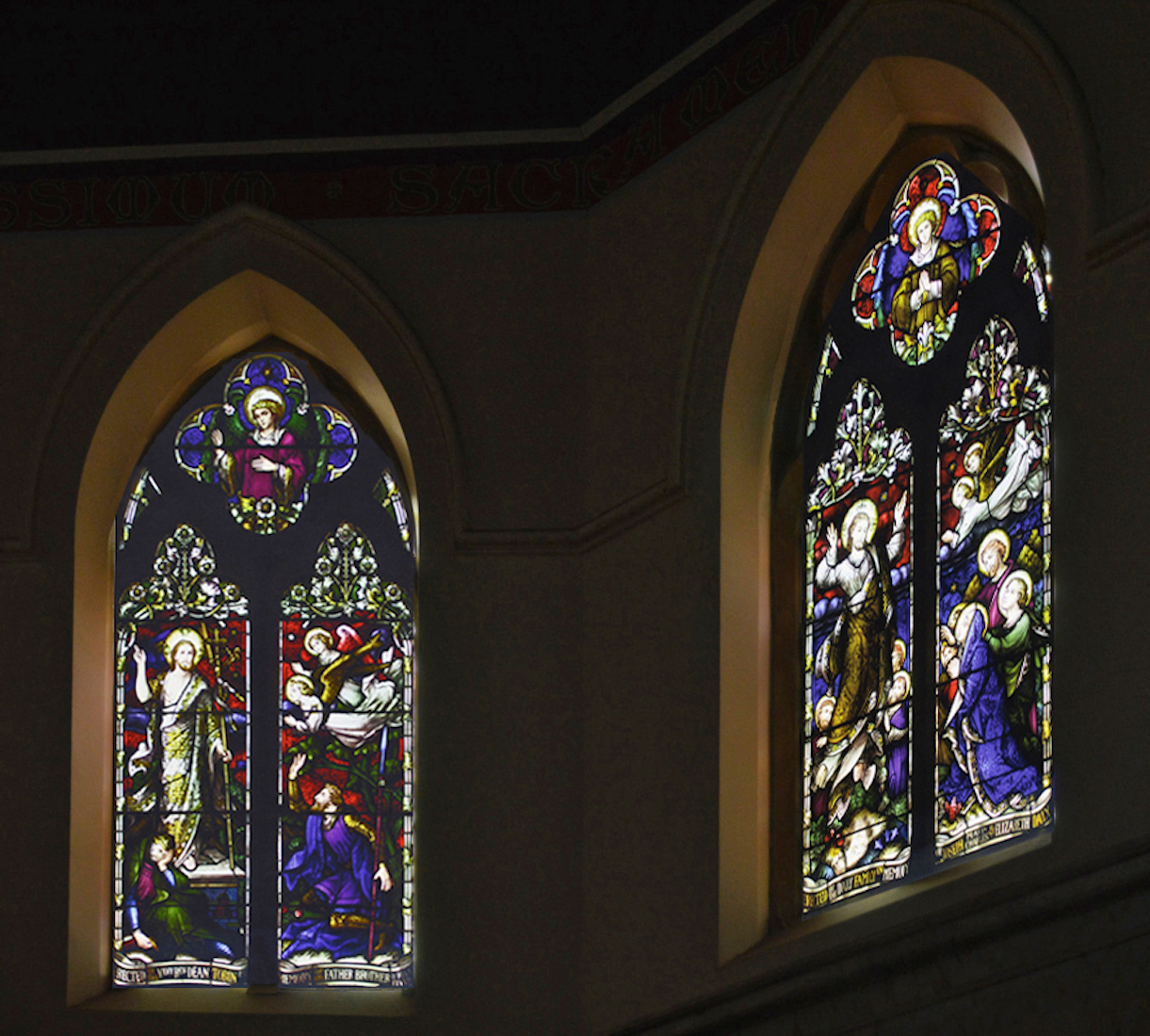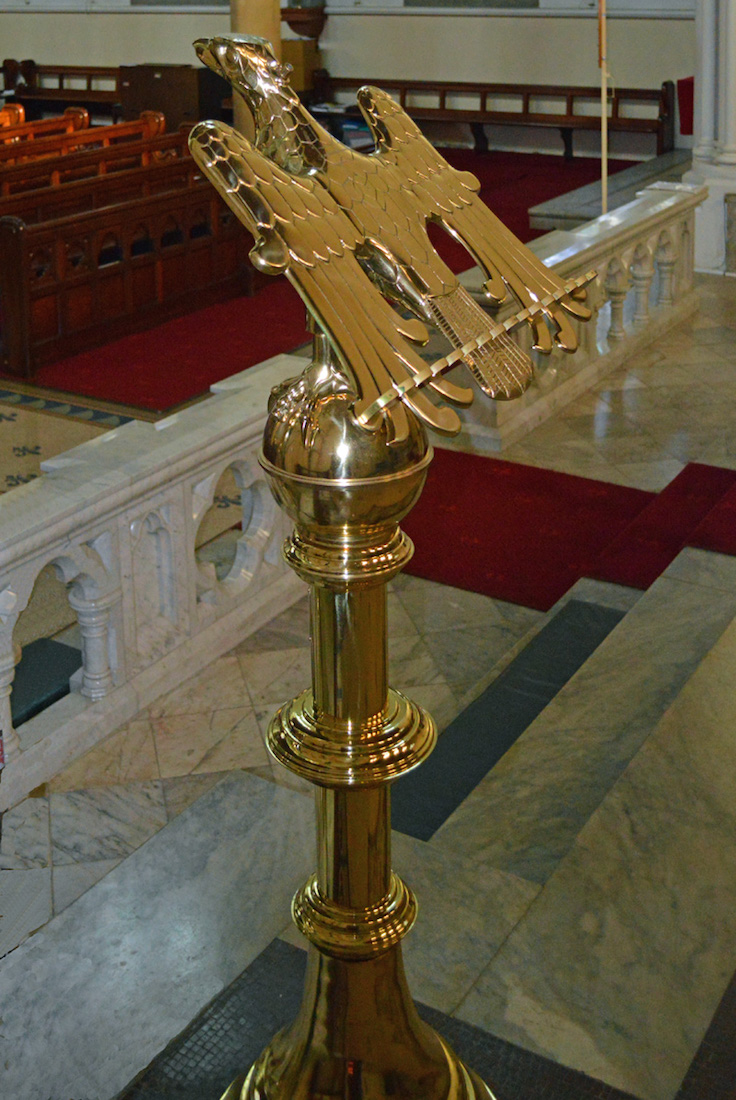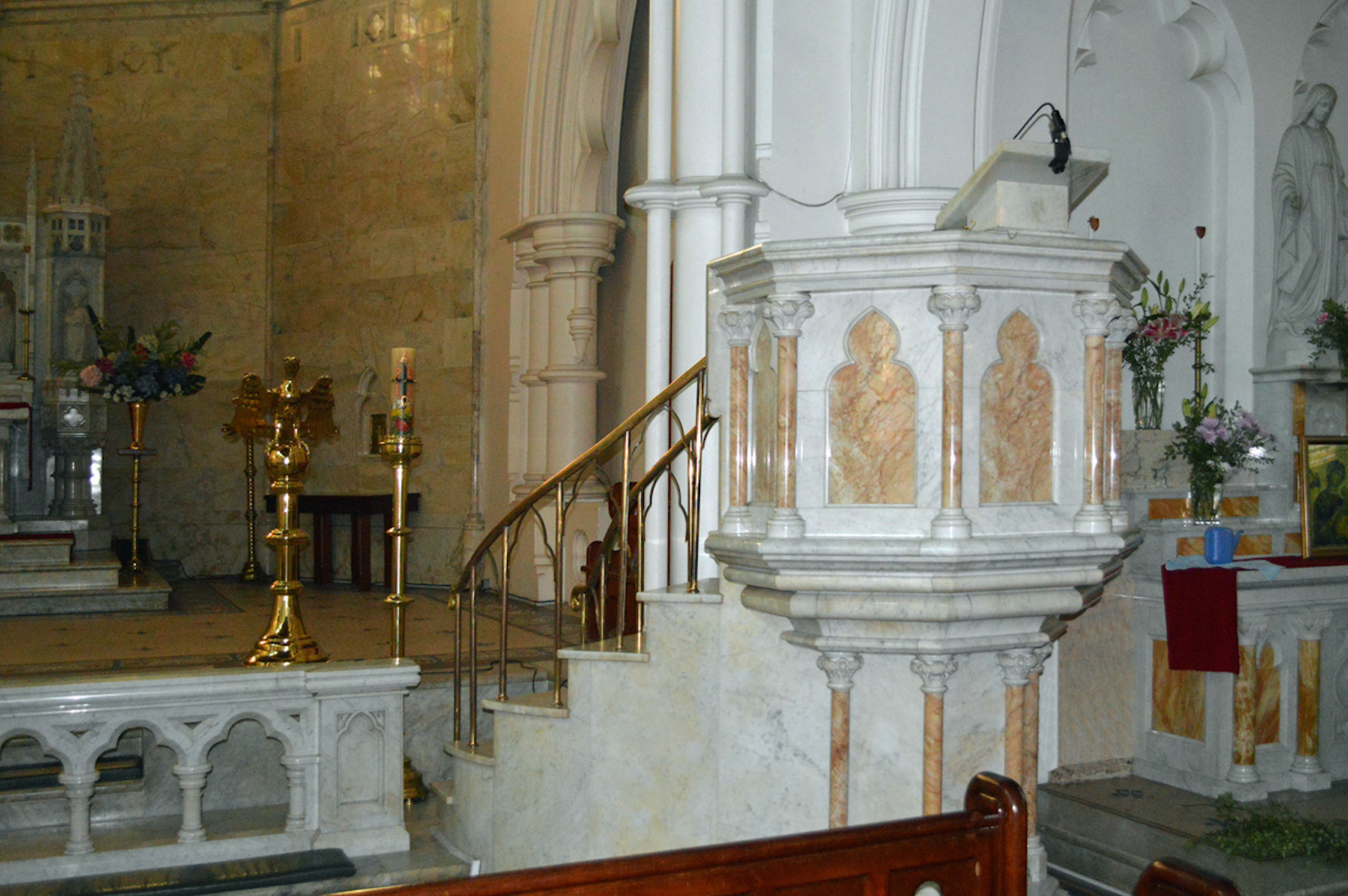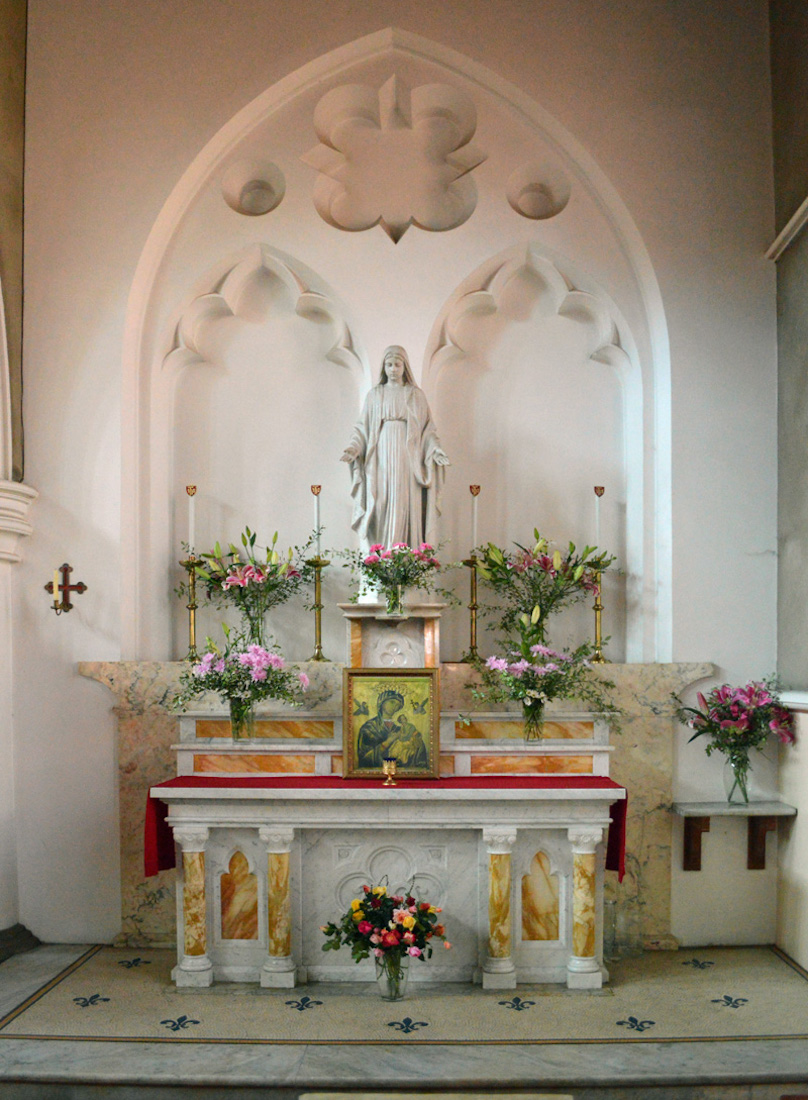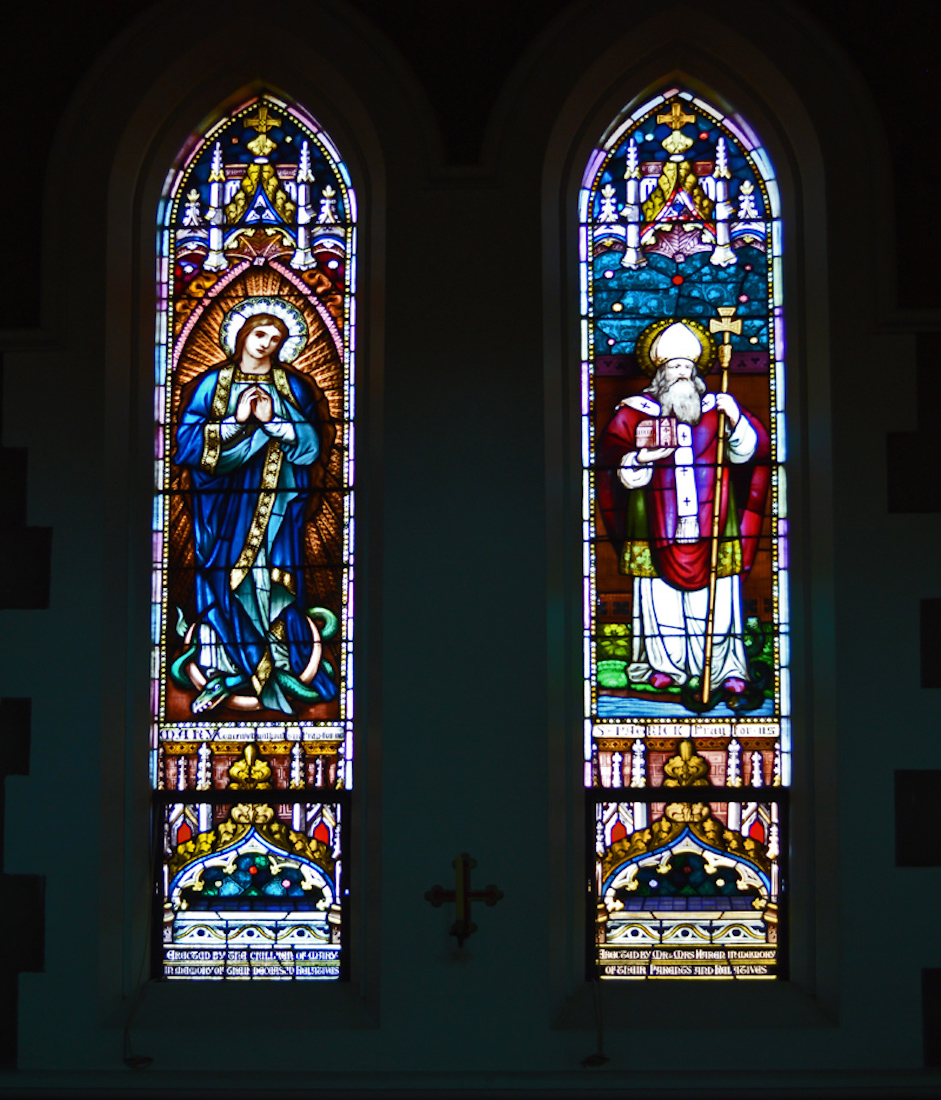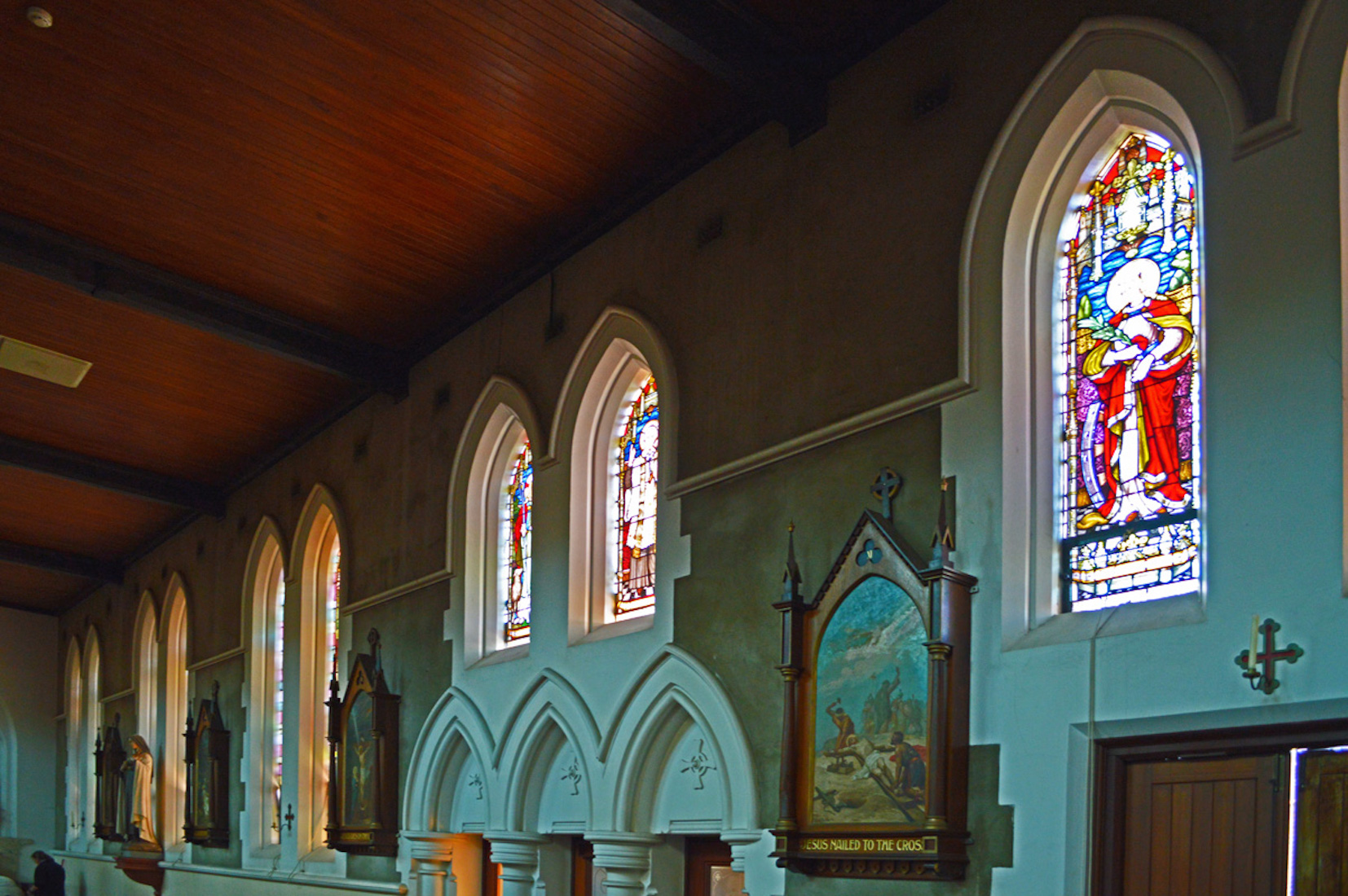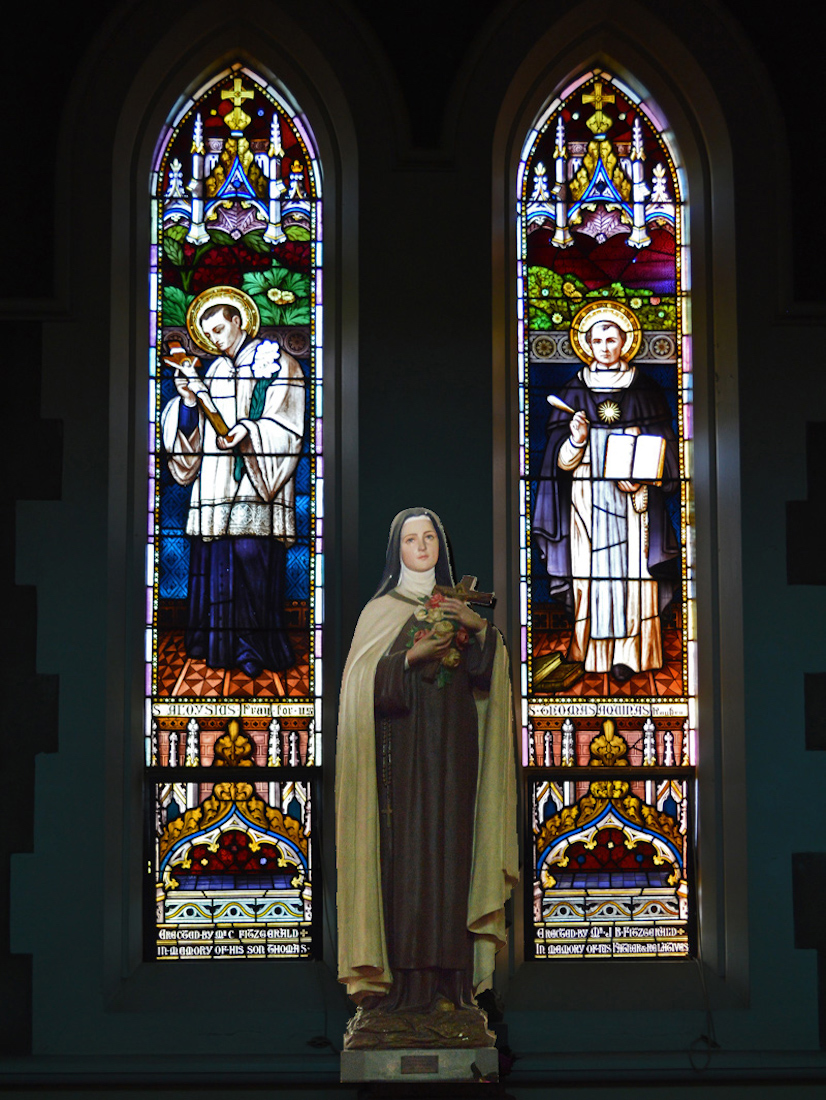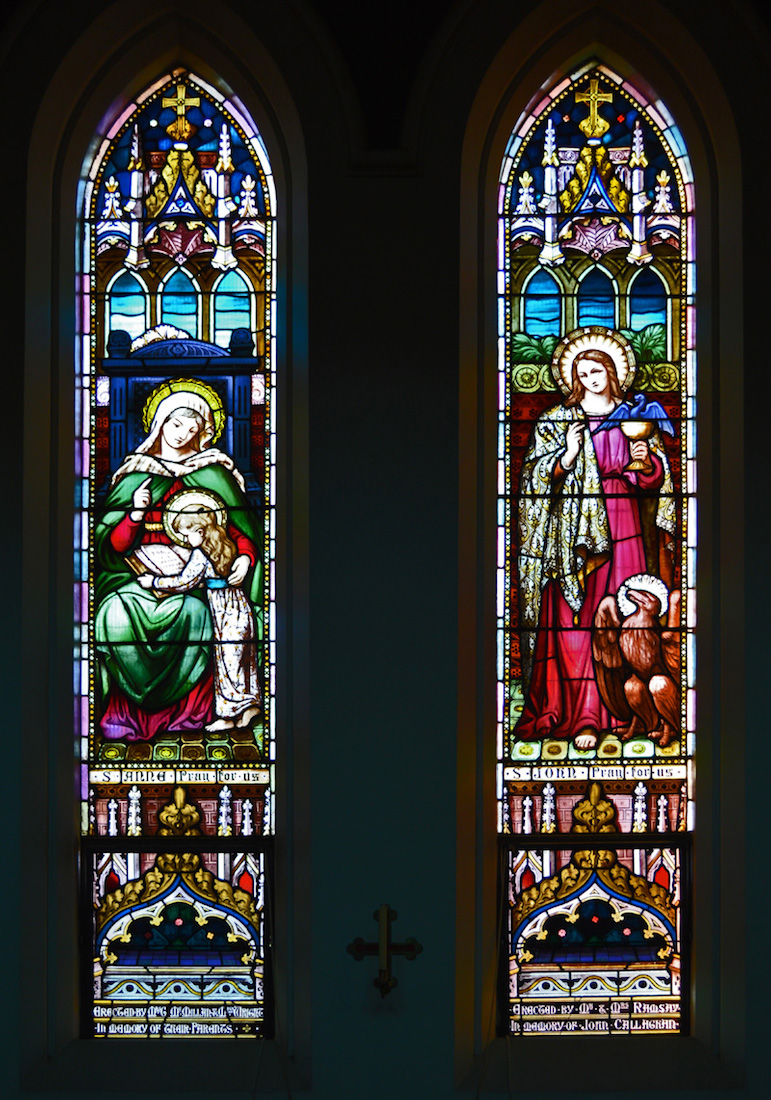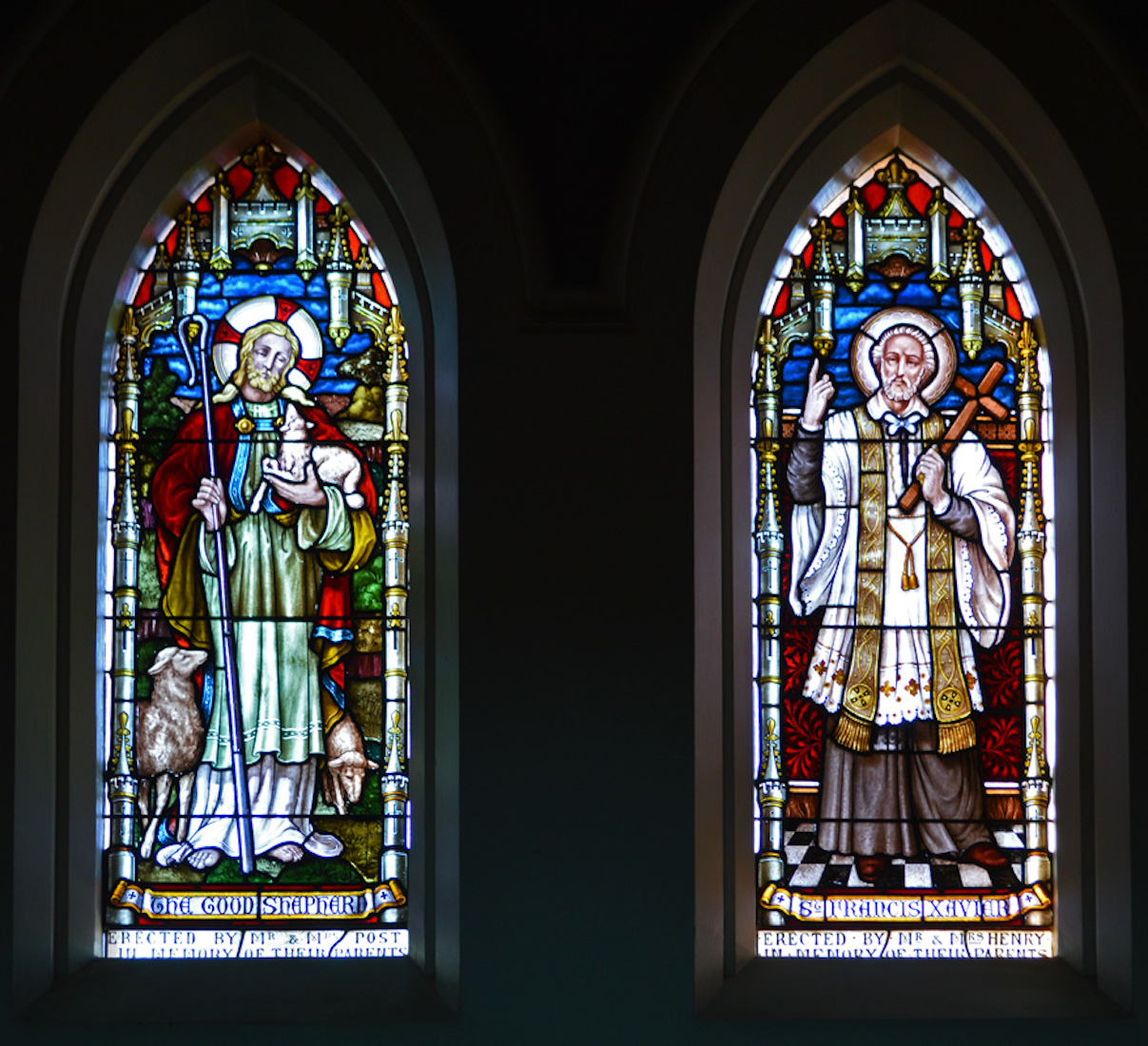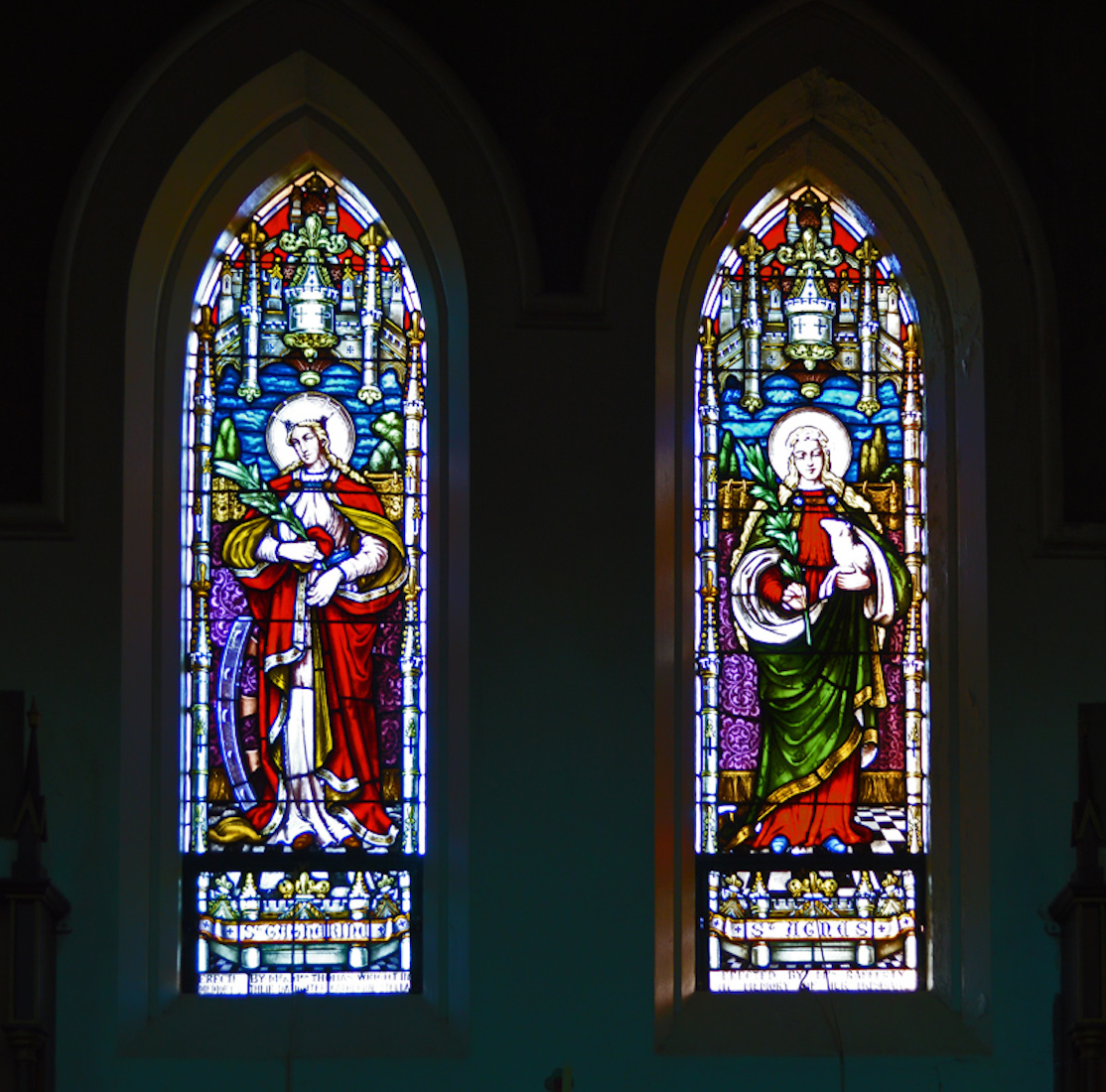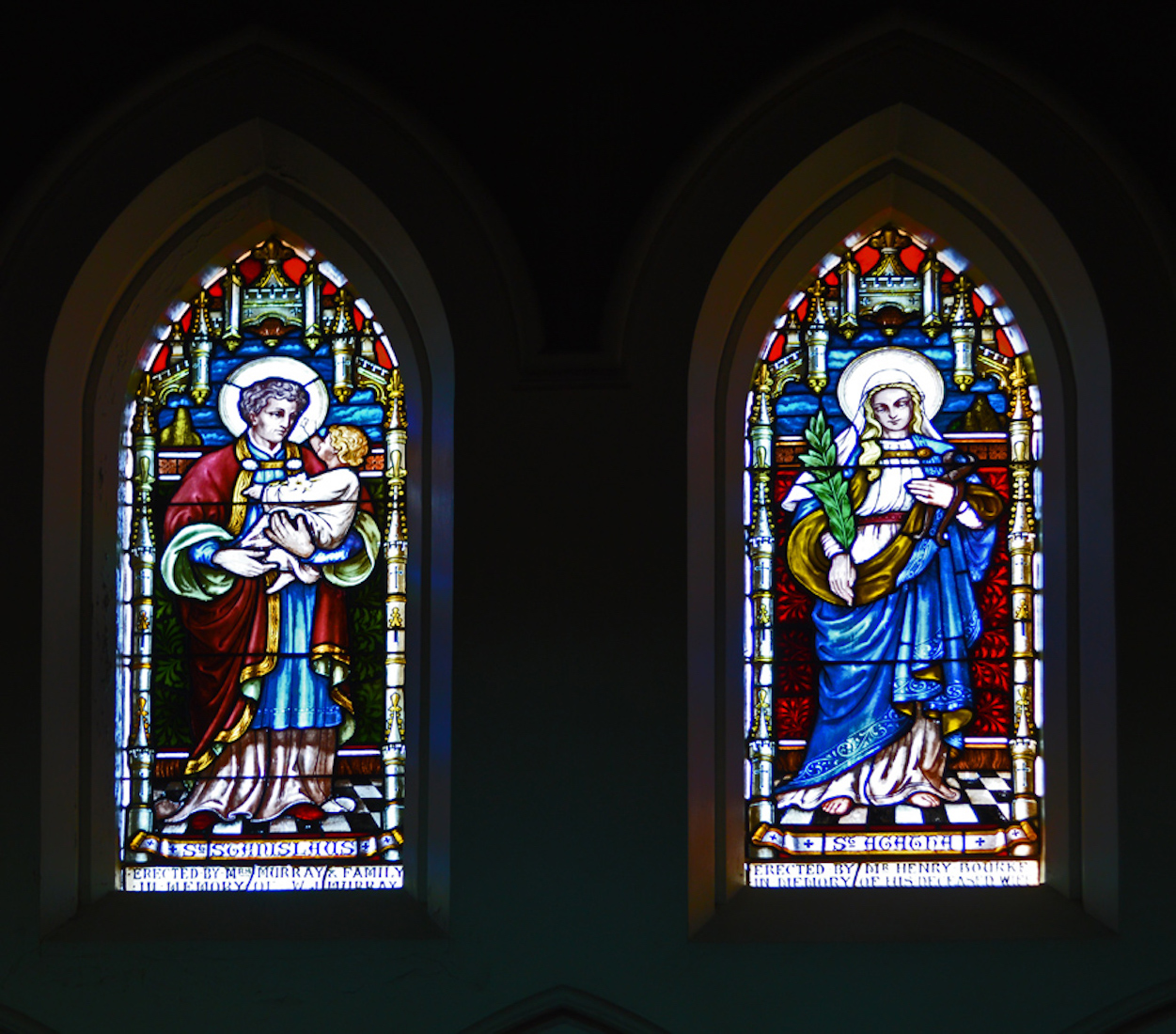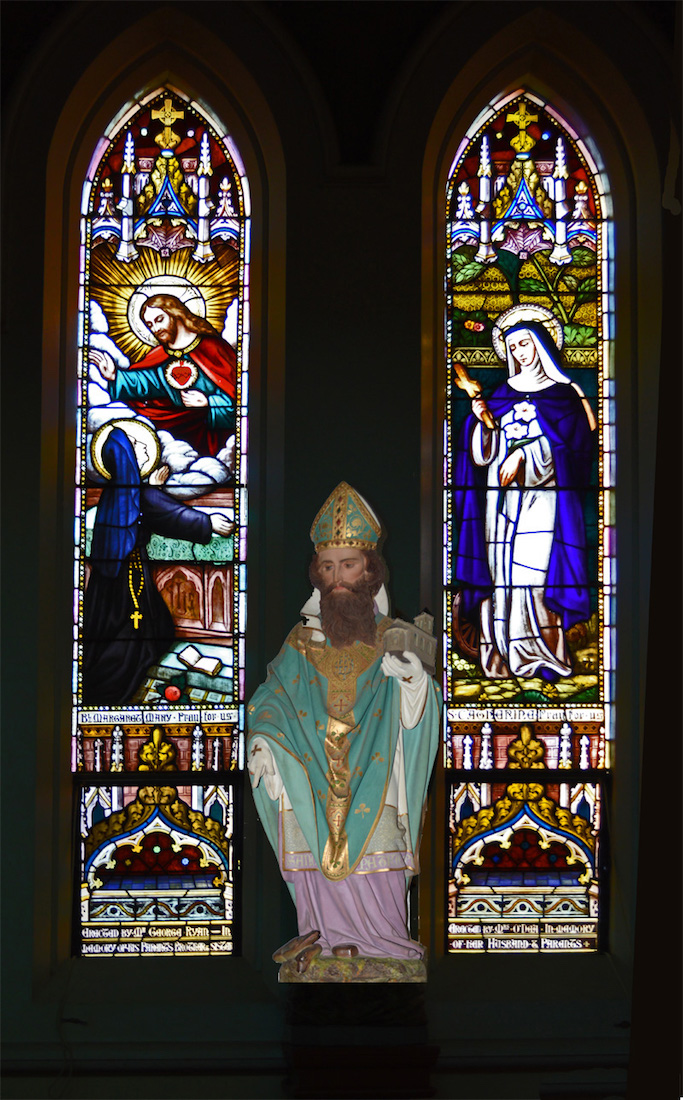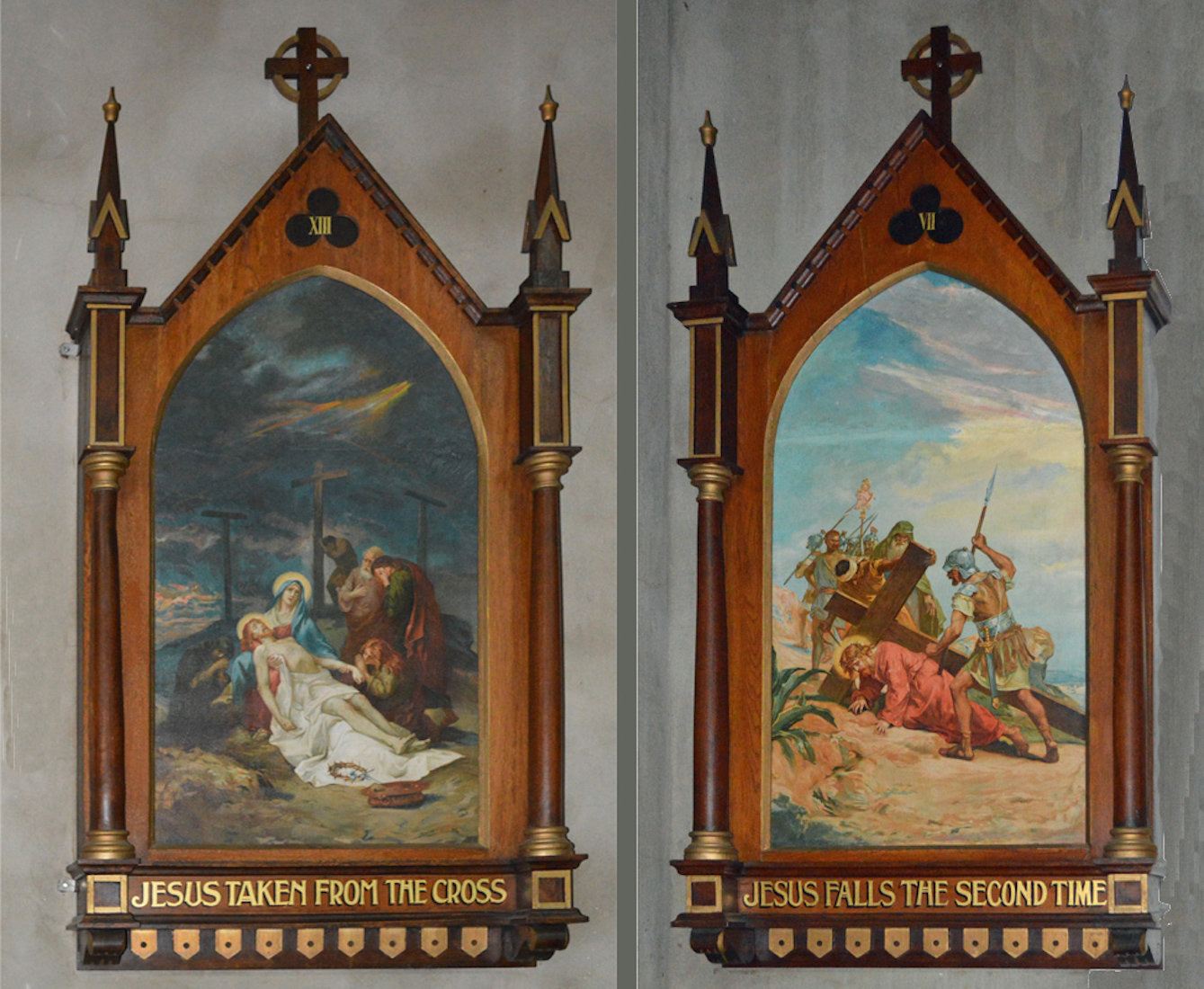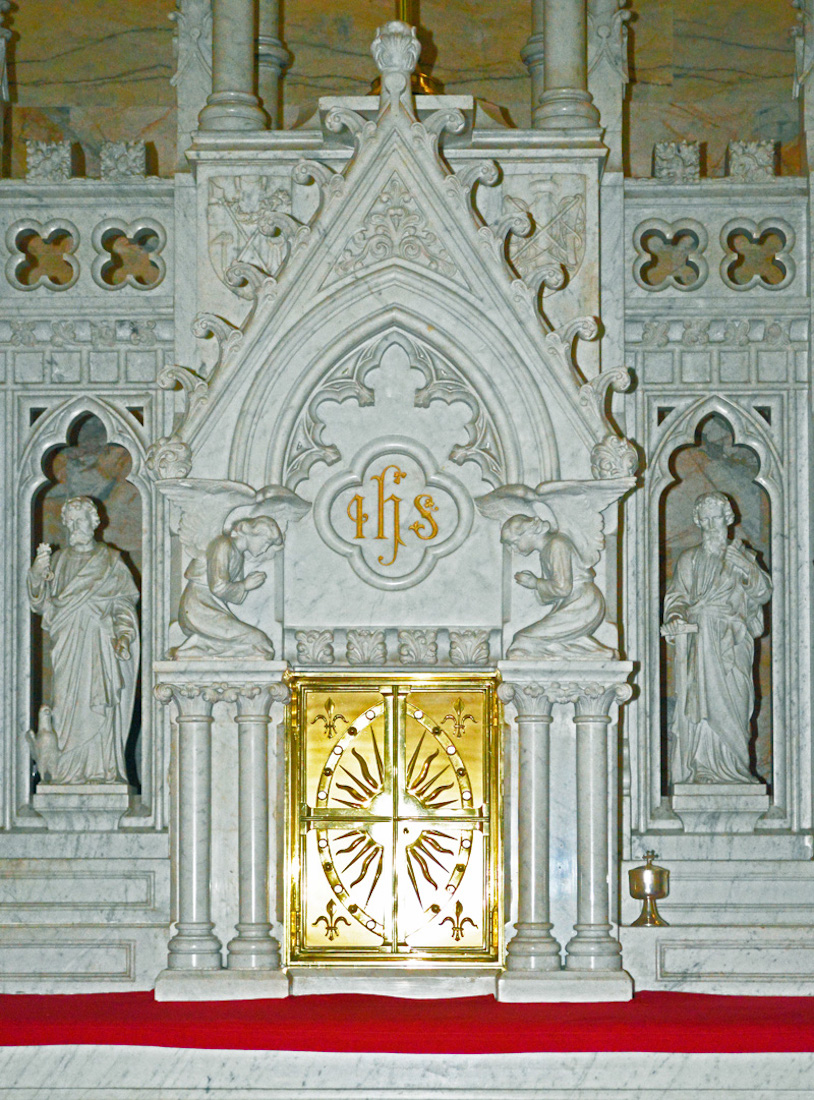
Here we see the tabernacle close up. The fleur-de-lis replicates the aisle motifs. The fancy letters IHS are the first three letters of ‘Jesus’ in Greek. At top are two shields, symbols of the Passion of Christ. Notice too the detail of the angels, mouldings and columns. PLAN
42. APSE WINDOWS
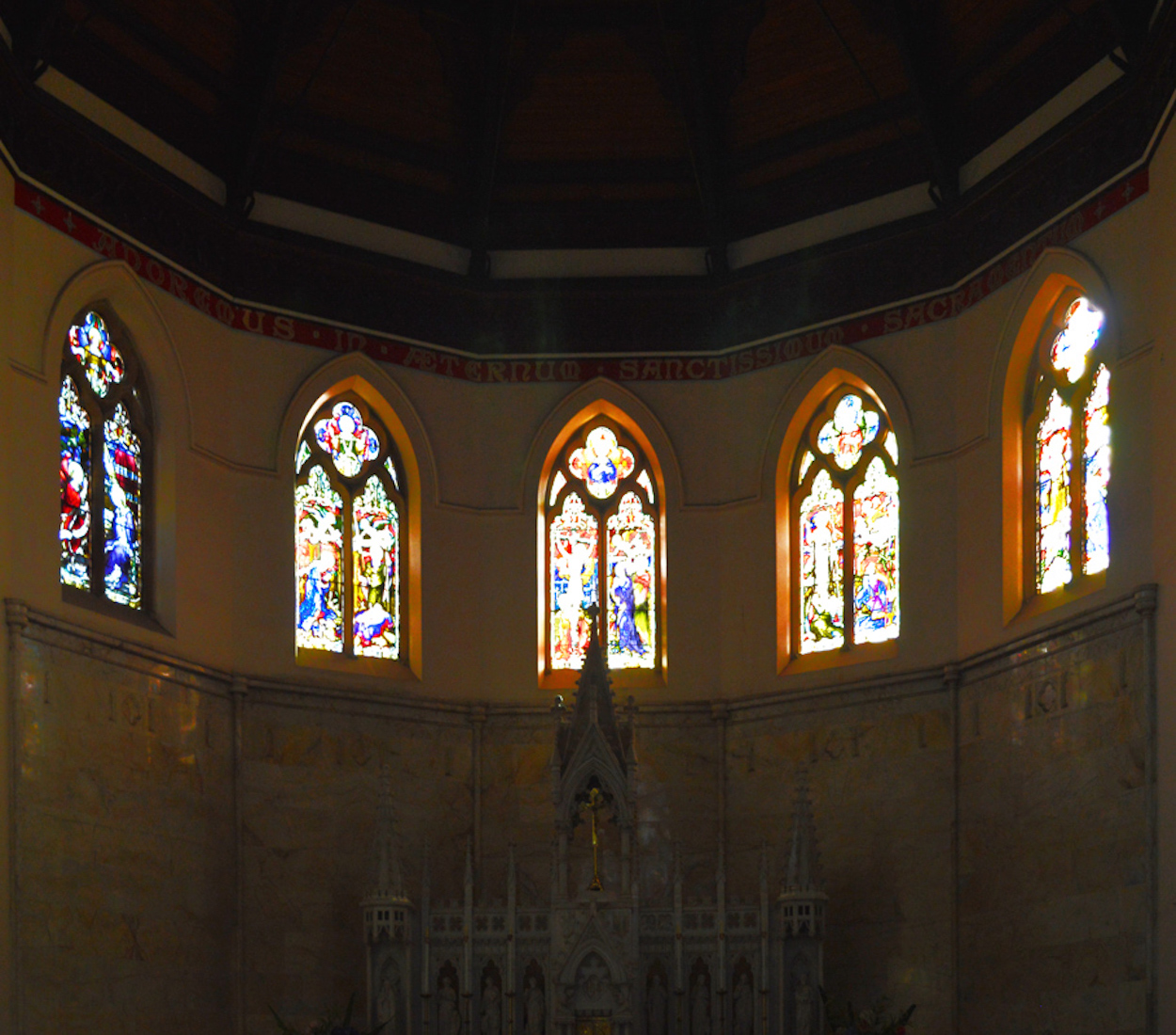
Above the main altar are five windows illustrating scriptural accounts of Jesus. From left we shall find the Annunciation, the Nativity, the Crucifixion, the Resurrection and The Ascension. The windows were crafted by John Hardman of Birmingham, England. We notice that angels are present in every window. Further, in the quatrefoil at the peak of each window, a ‘feature’ angel looks down, as it were, on the Mystery that is depicted.
43. APSE WINDOWS NORTH
The Northern Sanctuary Windows show the Annunciation and Nativity. In The Annunciation Window, the Angel Gabriel appears to Mary, telling her of the miraculous birth which is to follow. Gabriel carries a banner reading ‘Ave Gratia Plena‘ (Hail, full of grace). This window was erected by the Rev J. T. Clancy in memory of his parents and relatives. In the Nativity Window, the angels carry banners reading ‘Gloria in Excelsis Deo, et in Terra Pax’ (Glory to God in the highest and on earth peace). This window was erected by Mr M Brislane in memory of his parents and brother.
44. APSE WINDOW EAST
The central Eastern Crucifixion Window is somewhat concealed by the reredos of the high altar. The windows portray the scene of the Crucifixion with the three women watching on. The Cross bears the sign ‘INRI’ (Iēsus Nazarēnus, Rēx Iūdaeōrum) representing the Latin inscription which in English reads as ‘Jesus the Nazarene, King of the Jews’. The window was erected by Bishop O’Connor in memory of his parents and relatives.
45. APSE WINDOWS SOUTH
The Southern sanctuary windows portray the Resurrection and the Ascension. In the Resurrection Window, Jesus appears from the tomb. A slumbering soldier is at his feet, and he is greeted by a man with a spear (disciple/ centurion?) while two angels look on. This window was erected by the Very Rev Dean Tobin in memory of his father, brother and relatives. In the Ascension Window, Jesus is ascending before a group of His followers. This window was erected by the Daly Family in memory of Joseph, Mary, Charles and Elizabeth Daly.
46. APSE ROOF
The apse roof is a delight with its simple construction. The words in the red bordering strip read ADOREMUS IN AETERNUM SANCTISSIMUM SACRAMENTUM which is the first line of a Gregorian chant. It translates to: We will adore for eternity the most holy Sacrament
47. LECTERN
Near the front of the sanctuary stands a golden lectern. We have seen many eagle lecterns in our cathedrals. The flying eagle is the symbol of John the Evangelist (Revelation 4:7) who proclaimed Christ as 'the Word of God' at the beginning of his Gospel. The flying eagle is thus a suitable emblem from which God's Word is read, reaching the ends of the earth. The eagle is also thought of as the bird which flies nearest to heaven. This eagle has a particularly determined look!
48. PULPIT
Near the lectern and to the South side of the sanctuary stands the pulpit. This impressive marble pulpit replaces an earlier wooden pulpit. A marble reading desk is set into the stand.
49. OUR LADY ALTAR
Leaving the sanctuary we move back down into the nave. At the East end of the South aisle we have the Lady Altar – looking particularly lovely at the time of my visit!
50. SOUTH NAVE WINDOWS I
We now proceed back up the South aisle, examining the windows. The first window depicts Mary ‘conceived without sin’, and St Patrick. Belief in the Immaculate Conception has been held since Apostolic times, but was made a dogma of faith in 1854. The inscription reads: Erected by The Children of Mary in memory of their deceased relatives. Patrick is the Patron Saint of Ireland, and much has been written about him. He is depicted with a snake underfoot – a legend that he drove all snakes out of Ireland. The window was erected by Mr and Mrs Haren in memory of their parents and relatives.
51. SOUTH EAST NAVE
We take time to move further up the nave and look back along the South Wall. The Lady Altar is just out of sight at right.
52. SOUTH NAVE WINDOWS II
Our next pair of windows depict Saints Aloysius and Thomas Aquinas. St Therese stands between holding a Cross and flowers. St Aloysius (left) lived 1568 – 1591. He decided to join the Society of Jesus, much against the will of his father. He renounced his rights of inheritance and entered the Jesuit Novitiate in Rome in 1587. He died of plague four years later. This window was erected by Mr C Fitzgerald in memory of his son Thomas. Thomas Aquinas lived 1225 – 1274. He was a modest and unassuming man of deep prayer and spiritual insight. He was devoted to serving God through theological scholarship. The window was erected by Mr J. B. Fitzgerald in memory of his brother and relatives.
53. SOUTH NAVE WINDOWS III
The next windows portray Saints Anne and John. In a tradition dating back to the second century, the names of Mary’s parents are given as Anne and Joachim. This window was erected by Mrs G McMillan and Miss Wright in memory of their parents. St John was the Apostle, Evangelist and Beloved Disciple of Jesus. We read and deduce much about him in the New Testament. Of the four Evangelistic figures based on Ezek 1:10, John is depicted in iconography as an eagle because of the theological heights of the Prologue of the gospel. This window is erected by Mr and Mrs Ramsey in memory of John Callaghan.
54. SOUTH NAVE WINDOWS IV
Above the Eastern confessional there are two shorter windows: The Good Shepherd and St Francis Xavier. Jesus declares himself as ‘The Good Shepherd’ in John 13:1, and there are various other Biblical allusions. This window was erected by Mr and Mrs Post in memory of their parents. St Francis Xavier lived 1506 – 1551. He was a Jesuit missionary, and is Patron of Foreign Missions. He evangelized in India, Japan and China. He lived a life of extreme hardship and ceaseless activity, yet enjoyed a high degree of union with God in prayer. This window was erected by Mr and Mrs Henry in memory of their parents.
55. SOUTH NAVE WINDOWS V
Between the two Confessionals we find this pair of windows depicting SS Catherine of Alexandria and Agnes. Both are described as Virgin Martyr. Catherine (at left) died ca 305. Stories of her life come from two sources without historical value, but it is said that she was tortured on a wheel and then beheaded – hence todays ‘Catherine wheel’. The window was erected by Mr and Mrs Thomas Wright in memory of their daughter Catherine Stella. Little is known about St Agnes, but she lived before 354, and was martyred at age 13. Because her name is like agnus (lamb), she is usually pictured with a lamb. This window was erected by Mrs Rafferty in memory of her husband.
56. SOUTH NAVE WINDOWS VI
These two windows are above the Western confessional. They depict Saints Stanislaus and Agatha. St Stanislaus lived 1030 – 1079 and is the Patron of Poland. He was a pastoral bishop concerned with reform of the clergy and the sanctity of the people. The window was erected by Mrs Murray and family in memory of W. J. Murray. St Agatha, Virgin and Martyr, died ca 251. She is the Patron Saint of Sicily. Legend relates that she was sent to a brothel in order to induce her to repudiate her faith. When she refused she was tortured, her breasts severed and she was put to death. This window was erected by Mrs Henry Bourke in memory of his deceased wife.
57. SOUTH WEST NAVE
Nearing the Western end of the South aisle, we look towards the Baptistry. We note some more Stations of the Cross on which we have yet to comment, St Patrick, the Pièta, and more stained glass windows.
58. SOUTH NAVE WINDOWS VII
Our final windows on this South aisle depict Saints Margaret Mary (left) and Catherine of Siena. St Patrick stands between. Margaret Mary lived 1647 – 1690. She met with suffering early in her life, but during this time her understanding of suffering and of contemplative prayer developed. This window was erected by Mr George Ryan in memory of his parents, brother and sister. Catherine of Siena lived 1347 – 1380, and is the Patroness of Italy. From an early age she devoted her life to prayer and penance. She joined the Dominican Order and began nursing the sick and visiting prisoners. This window was erected by Mrs O’Dea in memory of her husband and parents.
59. STATIONS OF CROSS
The 14 Stations of the Cross line the walls of the cathedral. These depict the journey of Christ to His Crucifixion, and are used as a devotional aid. There are also twelve candle sconces with crosses on the walls to symbolize the consecration of the Cathedral in 1919.
60. BAPTISTRY
The Baptistry, in the South West corner of the Cathedral is very attractive. The colourful windows are a more modern style than the original, and were added at a later date. The windows have the themes (left to right): Suffer the little children to come unto me (Mk 10:14); This is my beloved Son in whom I am well pleased (Matt 3:17); and Going therefore, teach ye all nations (Matt 28:19,20). The windows were donated by: The Parishioners in memory of George McMillan; Bishop Doody in memory of his parents; Mr and Mrs J. M. Hanna in memory of their parents.


